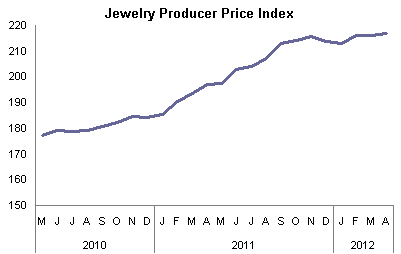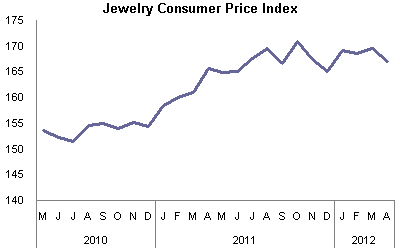IDEX Online Research: U.S. Retail Jewelry Prices Slip In April
May 29, 12
(IDEX Online News) – Retail jewelry prices in the American market fell by 1.5 percent in April, when compared to March prices. Further, retail jewelry prices rose by less than 1 percent year-over-year. It has been almost two years – immediately following the end of the Great Recession – since we have seen jewelry price inflation at this low level.
The full analysis and statistics on jewelry industry inflation for April 2012 is available to IDEX Online Research subscribers and IDEX Online members here.
While retail jewelry prices were essentially stagnant in April, suppliers’ jewelry and watch prices continued to move up, though at a slower rate than in past months. Jewelry producer prices rose by 10 percent when compared to April 2011, but were up only 0.3 percent (three-tenths of one percent) when compared to March 2012.
The moderating inflation trends are primarily the result of the lack of inflation this year for polished diamonds and precious metals. None of the key jewelry commodities – polished diamonds, gold, silver or platinum – posted price increases in April, when compared to March.
While inflation may have moderated in the jewelry distribution channel, the gap between jewelry retail prices and jewelry supplier / producer prices remained worrisomely wide. Essentially, jewelry wholesale prices are continuing to rise faster than jewelry retail prices; this results in a margin squeeze among retail merchants.
Jewelry Wholesale Price Inflation Moderates in April
In April, the Jewelry Producer Price Index (JPPI) stood at 216.9, barely up from March’s 216.2; a year ago, the JPPI stood at 197.0. Here is what this data means:
· Wholesale jewelry prices were almost flat on a month-to-month comparison basis: April versus March 2012.
· Wholesale jewelry prices rose by about 10.1 percent on a year-to-year comparison basis: April 2012 versus April 2011. This is down notably from the inflation rates in the first quarter of 2012.
· Wholesale jewelry prices were up 12.5 percent for the four months year-to-date 2012 versus the same period a year ago.
· The graph below summarizes the JPPI over the past two years.
 Source: BLS |
Jewelry Retail Price Inflation Evaporates in April
In April, the Jewelry Consumer Price Index (JCPI) stood at 167.1 versus March’s 169.6; a year ago, the JCPI stood at 165.6. Here is what this means:
· Retail prices of jewelry dropped by about 1.5 percent on a month-to-month comparison basis: April versus March 2012.
· Retail jewelry prices rose by a very modest 0.9 percent on a year-to-year comparison basis: April 2012 versus April 2011. In part, this is due to a steep rate of inflation during April 2011, so comparisons were very modest this year.
· The graph below summarizes the JCPI over the past two years:
 Source: BLS |
Jewelry Inflation Outlook: Moderating Inflation in 2012
Our outlook for jewelry price inflation remains unchanged: jewelry prices are expected to move higher at all levels of the distribution channel throughout 2012 and perhaps beyond. However, the rate of inflation is expected to be below 2011’s torrid pace, both at the supplier level and at the retail level.
It would be easy to forecast inflation for the jewelry industry if all of the commodities involved in the forecast were used exclusively by the jewelry industry. While that may be the case for polished diamonds, a number of other industries use precious metals. Further, gold is an international currency that plays in a financial arena of its own.
· Jewelry Industry Long Term Outlook – Demand from emerging economies such as
· Global Economic Outlook for 2012 – The latest OECD data points to moderate economic growth with a “positive” outlook for stronger growth in the next 12-18 months. However, there is some divergence among the growth of certain economies, especially given the current fiscal problems in
· Financial Markets Outlook for 2012 – With continued volatility in the world’s stock markets and uncertain valuations related to stocks, bonds and other hard assets, investors may seek the safe haven that gold offers. Despite predictions by others that gold will hit $2,000 this year, we are not ready to embrace those forecasts. This level would represent a mid-teen price increase. We see investor movement toward income-producing assets, and a move away from assets that do not produce income or an inflation hedge, such as gold.
The bottom line: inflation is headed higher over the longer term, but perhaps at a more moderate rate. Jewelry suppliers and retailers should use periods of weakness in commodity prices to add to their inventory.
The full analysis and statistics on jewelry industry inflation for April 2012 is available to IDEX Online Research subscribers and IDEX Online members here. Click here for more information on how to subscribe or become a member.